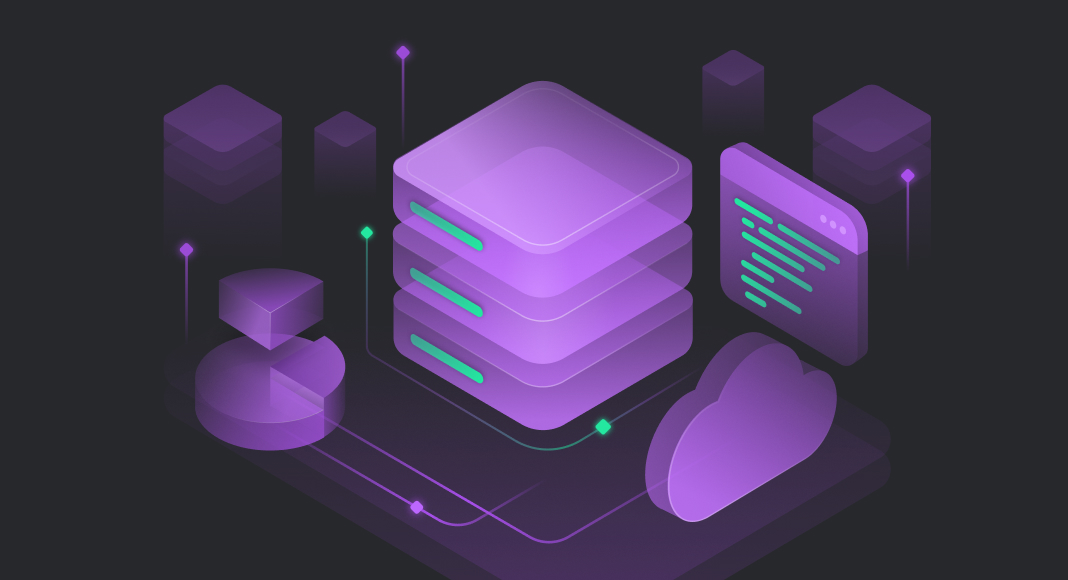Modern cloud solutions mean much more than just data storage. Cloud technologies cover virtual services, including analytics, databases, networking, servers, and storage via the internet. Such a giant as Microsoft is among the most prominent cloud providers with its Azure platform.
“Platform as a Service,” or PaaS, is a popular solution for database specialists. It is a powerful database engine that allows you to perform most database management routines. Upgrading, updating, backups, and monitoring tasks are all covered by the provider. It provides high availability with a 99.995% SLA and is always kept up to date.
At the current stage, Azure SQL PaaS offers the latest version of the SQL Server database engine with complete support for all features. This way, you can focus on specific database tasks and never worry about general optimization and administration routines.
Azure SQL Database is a part of the entire Microsoft Azure PaaS franchise—a combination of several innovative products integrated with the Azure Cloud platform:
- Azure SQL Database is a product provided under the database-as-a-service model. It offers the Azure PaaS SQL capacities to build applications and websites, while Microsoft manages the infrastructure.
- Azure SQL Managed Instance is the SQL Server engine as PaaS, including familiar tools and resources to accomplish database-related jobs. You can customize the engine, configure the recovery model, run and control the maintenance, etc. The Managed Instance is the best solution for migrating your workloads to the cloud.
- SQL Server on Azure Virtual Machines (VMs) is the infrastructure as a Service (IaaS) solution—the SQL Server that runs in a virtual machine in the cloud. You can apply the SQL Server license you already have or use the capacities of the Azure portal. This model suits both development and migration purposes, and it is perfect for organizations that already work with virtual machines.
This article will explore the Azure SQL Database.
Table of contents- Azure SQL Database
- Deployment models
- Purchasing models
- Service tiers
- Advantages of the Azure SQL Database
- dbForge SQL Server tools
- Conclusion
- FAQ
Azure SQL Database
Azure SQL Database is a cloud-based database service for SQL Server devotees. Microsoft takes on the servers’ and data centers’ administration, including patches, upgrades, and backups.
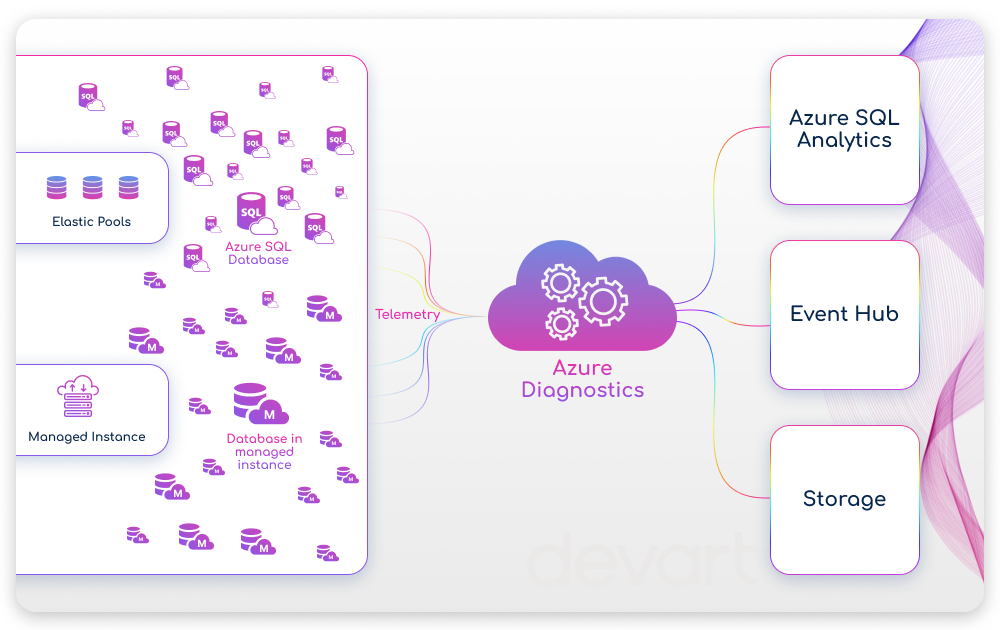
Microsoft Azure SQL Database allows you to migrate your projects/applications to the cloud—easily and securely, with minimum changes and no database downtime. The application performance becomes much more stable and predictable. Also, you can have multiple Azure SQL databases and manage them more effectively at a lower cost.
The maximum size of the Azure SQL Database is now 2TB for a single database. The available storage size depends on the chosen service tier.
Deployment models
There are two deployment models for Azure SQL databases: single database and elastic pool. Both have their peculiarities.
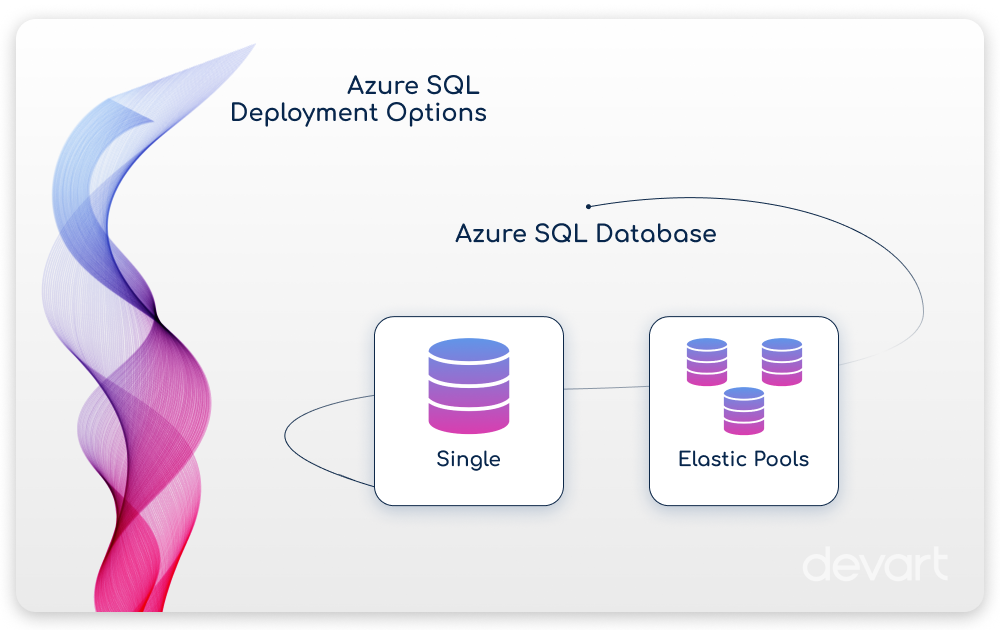
Single database
A single database on the Azure SQL platform is equivalent to an SQL Server database, which is hosted in the cloud. This database is isolated from other databases and managed via a server. When you assign resources to every single database, they belong to it only, not shared with other databases, under any service tier.
The single database deployment model is a solution for a cloud application that requires a single data source. Also, it is possible to scale up or down the resources allocated to the particular database.
Elastic pool
This deployment model relates to multiple databases with shared resources managed altogether via a logical server. You can move a single database into this elastic pool or remove it from there whenever you need.
The elastic pool is a solution for several databases, where each database requires resources to work effectively. If you don’t know how many resources each particular database will consume and how much you should allocate at once, then the work is challenging. The SQL pool in Azure resolves this issue in the following way: when any separate database sets unique and unpredictable resource requirements, the elastic pool allocates the necessary resources to the target database itself.
The ability to handle resource requirements is measured in DTUs (Database Transaction Units) for single databases and eDTUs (elastic Database Transaction Units) for elastic database pools.
The pool receives a definite number of eDTUs for a set price. Therefore, a user pays for the Azure SQL elastic pool as a single whole, not for each separate database. Within the pool, an individual database can consume more eDTUs, taking them from the overall number present, if the load grows. When the load is less or absent, no eDTUs are consumed.
One more essential issue is storage. The elastic pool specifies the storage in GBs, and you can share it between all databases. However, you can’t exceed this storage limit. If your databases grow too large and their aggregated size goes beyond the elastic pool storage, all databases become read-only.
You can add more eDTUs to the elastic pool. Vice versa, you can remove extra eDTUs from the pool if databases don’t consume them. It’s possible to do this at any moment, and it won’t cause any negative impacts or downtime.
Comparison between a single database and an elastic pool
| Feature | Single database | Elastic pool |
|---|---|---|
| Resource Model | Dedicated resources per database | Shared resources across multiple databases |
| Best For | Predictable and consistent workloads | Variable or unpredictable workloads across many databases |
| Cost Model | Pay per database, regardless of usage | Pay for the pool; usage balanced across all databases |
| Performance Scaling | Scale each database independently | Scale the entire pool, shared among databases |
| Management Complexity | Simple for managing a few databases | More efficient when managing many databases simultaneously |
Purchasing models
You can purchase the cloud-based Azure SQL Database under the vCore and DTU models. Let us review them more precisely.
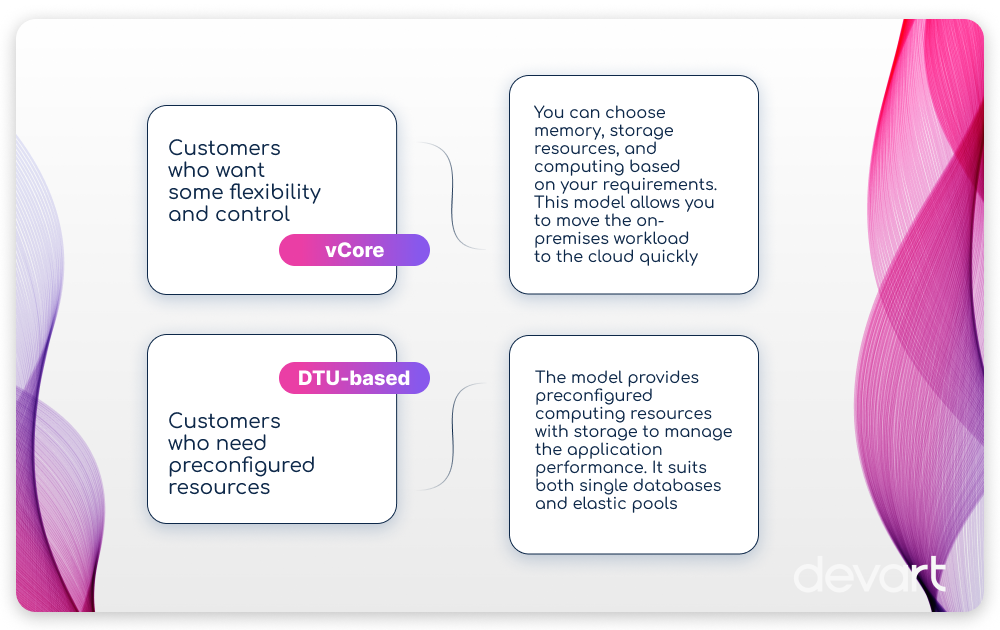
vCore purchasing model
vCore stands for “virtual core” and represents a logical CPU. The model is also known as serverless. If you choose this model, you can specify the hardware characteristics you want to have in the cloud, such as memory, storage, the number of cores, etc. This option lets you “transfer” the requirements from on-premise to the cloud, ensuring that you have the required environment to work with databases most efficiently. Also, you can migrate your applications to the cloud easily.
The price will depend on the service tier and your particular requirements for the resources, storage, and hardware configuration. The vCore-based model is available in Standard, Premium, and Hyperscale service tiers.
DTU-based purchasing model
DTU stands for the Database Transaction Unit—a measure for the bundle of computing and storage. The DTU-based purchasing model means that you receive the preconfigured bundle that covers the CPU capabilities and memory under fixed monthly payments. It suits both single databases and elastic pools.
This model is available in Basic, Standard, and Premium service tiers. The Standard and Premium tiers allow you to add more storage. In general, under this model, you get a certain granted level of resources for any database, and it does not matter if there are other databases. Thus, each database will perform predictably.
Users who seek preconfigured resources usually prefer going with the DTU-based model. It is simpler. The vCore-based model requires more effort from the customer’s side, but it provides more flexibility and control. For instance, the serverless compute tier available under the vCore model lets you scale the compute resources, pause the databases automatically during periods of inactivity, resume them when necessary, etc.
Microsoft recommends the vCore-based model for customers, but you can choose the option that suits you best. Switching from the DTU-based model to the vCore-based one is possible at any moment.
Comparison between the Azure purchasing model
| Feature | DTU-Based Model | vCore-Based Model |
|---|---|---|
| Resource Abstraction | Combines CPU, memory, and I/O into a single unit called DTU | Low—fixed performance tiers |
| Control & Flexibility | Limited—less control over resource optimization | Separates the configuration of CPU, memory, and storage |
| Service Tiers Available | Basic, Standard, Premium | General Purpose, Business Critical, Hyperscale |
| Performance Tuning | Limited — less control over resource optimization | Limited—less control over resource optimization |
| Use Case Suitability | Ideal for small to medium workloads | Designed for medium to large workloads and mission-critical apps |
Service tiers
Azure SQL Database offers a range of service tiers designed to meet diverse business and technical requirements. These tiers—general purpose, business critical, and hyperscale—balance performance, scalability, high availability, and cost-efficiency. Microsoft has deprecated the older Basic, Standard, and Premium DTU-based tiers in favor of the more flexible vCore-based model, which is now the recommended standard.
General purpose (formerly Standard)
The general purpose tier is ideal for most business applications and standard workloads that don’t require ultra-low latency or intensive compute. It uses remote Azure Premium SSD-based storage with high availability built in via Azure Service Fabric. This tier supports storage sizes ranging from 5 GB to 4 TB and provides a cost-effective option for applications with typical performance needs. Microsoft handles all patching, backups, and maintenance operations.
Business critical (formerly Premium)
The business critical tier is tailored for high-performance applications where speed, availability, and resilience are essential. It provides local SSD storage with low-latency I/O and uses a replica-based high availability architecture, making it ideal for mission-critical workloads. Like General Purpose, it supports up to 4 TB of storage but delivers significantly better performance and faster recovery in case of failures.
Hyperscale
Hyperscale is the most advanced service tier, purpose-built for extreme scalability. It supports databases up to 100 TB and offers rapid scaling of storage and compute independently. Hyperscale enables nearly instantaneous backups and fast restores, even for very large databases. It is optimal for SaaS providers, analytics-heavy applications, and systems where data growth is unpredictable. This tier takes advantage of a unique architecture that separates compute and storage layers, improving agility and performance.
| Mission-critical, high transaction volume | Best use case | Compute | Max storage | Key features |
|---|---|---|---|---|
| vCore-Based | ||||
| • Basic | Small apps, development, testing | 5 DTUs | Up to 80 vCores | Balanced compute and storage uses remote disk storage |
| • Standard | Business apps with moderate performance | Up to 80 vCores | Up to 100 TB | Balanced performance, cost-effective |
| • Premium | Large databases, fast read scale-out | 10–3,000 DTUs | 2 GB | High IOPS, premium availability |
| 125–4,000 DTUs | ||||
| • General Purpose | Most business apps | 2 GB | Up to 4 TB | Balanced compute and storage, uses remote disk storage |
| • High-performance apps, low latency | Mission‑critical, high transaction volume | 0.5–40 vCores (auto-scaling) | Up to 4 TB | Local SSD, fast failover, zone redundancy |
| • Hyperscale | DTU-Based | Balanced compute and storage uses remote disk storage | Up to 1 TB | Rapid autoscaling, fast backup/restore |
| vCore (special) | ||||
| • Serverless | Infrequent or intermittent usage | Up to 80 vCores | 1.5–4 TB | Auto-pause/resume, billed per second |
All service tiers are billed per hour, and you can scale between them at any time using the Azure portal or by running SQL commands. Choosing the right tier depends on your specific needs for storage size, throughput, resilience, and cost control. Azure SQL ensures a seamless transition between service tiers with minimal downtime, allowing your database to grow and adapt alongside your business.
Advantages of the Azure SQL Database
Microsoft was among the major players who launched and shaped modern cloud platforms, creating a comprehensive infrastructure to manage data and databases. Azure SQL Databases are perfect replacements for “standard” SQL Server databases on-premises. Besides, the Azure cloud offers additional benefits.

Security and compliance
Azure cares about the customers’ data safety. The firewall prevents any unauthorized access to databases, and virtual network rules ensure that requests are accepted only from selected subnets. It tracks malicious activities that threaten the safety of databases and sends alerts to customers.
Threat protection
Advanced Threat Protection provided by Microsoft Azure delivers a new level of database security. The tool detects and fixes any anomalies and vulnerabilities. You can receive alerts and email notifications to inform you about suspicious activities, SQL attacks, abnormal database access, and query patterns.
Performance monitoring, tuning, and alerting
Azure SQL Database monitors CPU and IO according to the service tier and lets customers view the Query Performance Insights. The system provides recommendations on performance optimization, and you can configure the implementation automatically. An AI is used to troubleshoot issues and help you maximize database performance.
Learn how to use Azure SQL export database methods in this article.
What is the difference between an Azure SQL Database and a SQL database?
Azure SQL Database and SQL Server (traditional SQL database) offer similar capabilities in terms of data storage and querying, but they differ significantly in how they’re deployed, managed, and scaled. Here’s a breakdown of the differences between these two databases
| Aspect | Azure SQL Database (PaaS) | SQL Server (On-Premises or IaaS) |
|---|---|---|
| Hosting | Cloud-native (PaaS) on Microsoft Azure | On-premises or on a VM (e.g., Azure VM, physical server) |
| Deployment model | Platform-as-a-Service (PaaS) | License is included in Azure pricing |
| Management | Fully managed by Microsoft (patches, backups, updates) | Managed by the user or database administrator (DBA) |
| High availability | Built-in, with 99.99% SLA | Requires manual setup (e.g., Always On, clustering) |
| Scalability | Easily scalable (up/down, across regions) | Manual scaling via hardware or VM configuration |
| Backups | Automatic, with configurable retention policies | Requires manual configuration and maintenance |
| Disaster recovery | Built-in geo-replication and disaster recovery | Manual setup (e.g., Log Shipping, Mirroring) |
| Security | Integrated security features like threat detection, RBAC | Infrastructure-as-a-Service (IaaS) or a traditional on-premises setup |
| Performance tiers | Multiple (DTU & vCore models), with auto-scaling capabilities | Static performance tied to physical/virtual hardware |
| Licensing | License-included in Azure pricing | Requires separate licensing (or Azure Hybrid Benefit) |
| Cost | Pay-as-you-go, consumption-based pricing | Upfront infrastructure and licensing costs |
| Use case | Ideal for modern cloud apps, SaaS platforms, mobile/web apps | Preferred for legacy systems, full OS control, and deep customization |
dbForge SQL Server tools
Devart provides quite a wide range of tools to work with the Azure SQL Database. Let’s review each of them.
dbForge Studio for SQL Server
dbForge Studio for SQL Server is a multifunctional tool that allows you to move your work with databases to a higher level of performance. With the tool, you can complete database-related tasks in a fast way: design databases, write SQL code, compare databases, synchronize schemas and data, create data reports and pivot tables, implement database CI/CD, and much more.
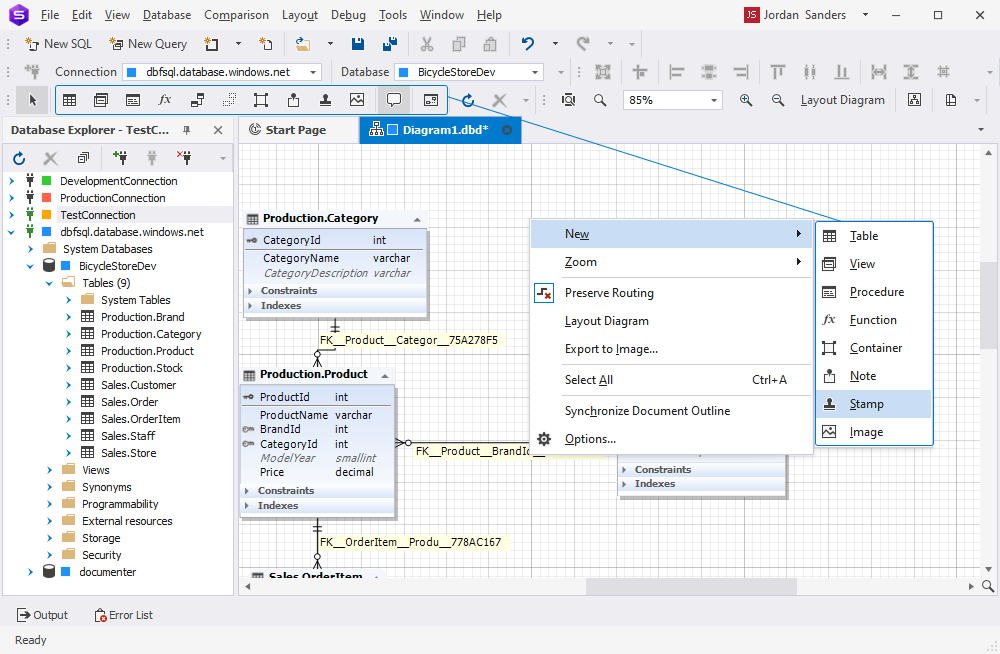
dbForge SQL Complete
dbForge SQL Complete is an add-in for Visual Studio and SSMS with powerful autocompletion and code formatting capabilities. The tool can come in handy when you need to significantly increase your coding speed and productivity and reduce the number of random syntax errors.
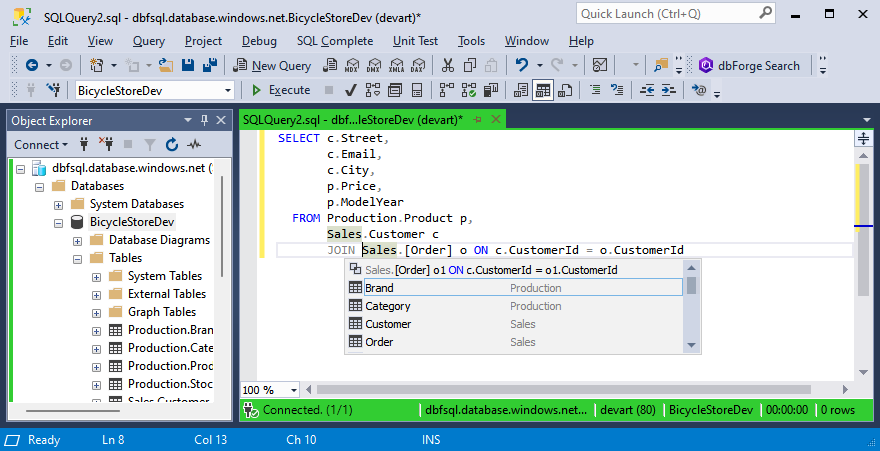
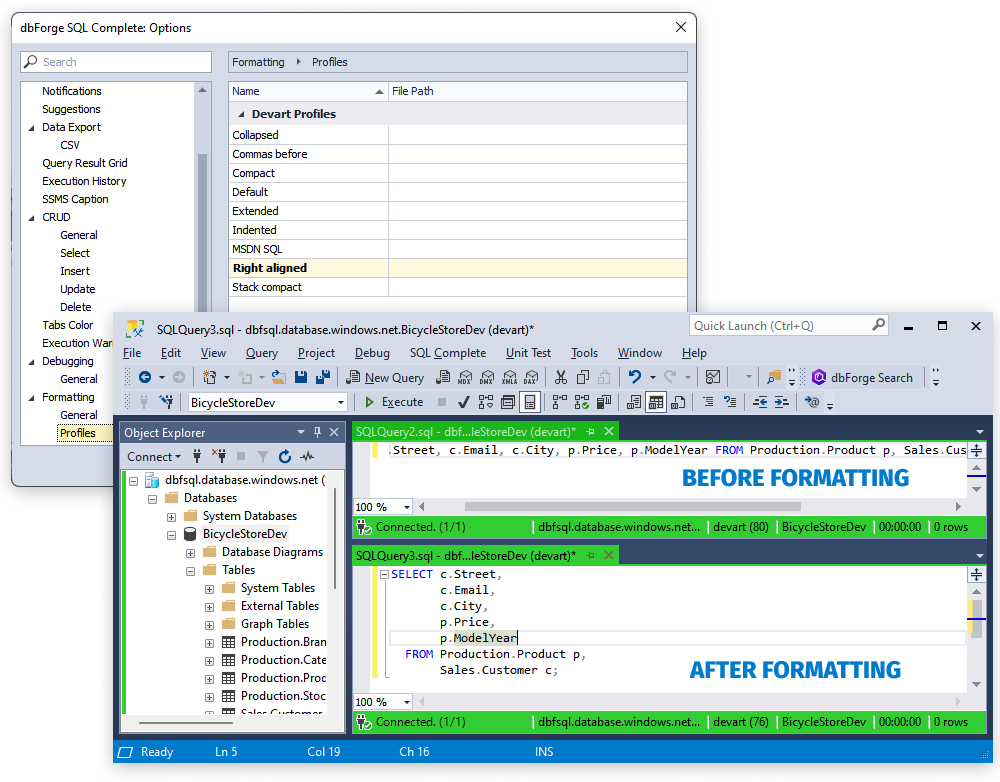
dbForge Schema Compare for SQL Server
dbForge Schema Compare for SQL Server is a database comparison tool that provides the possibility to work with live SQL Server databases, snapshots, script folders, and native backups. The tool allows you to compare and synchronize SQL databases and generate interactive HTML reports based on the comparison result. Thus, you can analyze differences and perform schema synchronization without errors using generated SQL scripts.
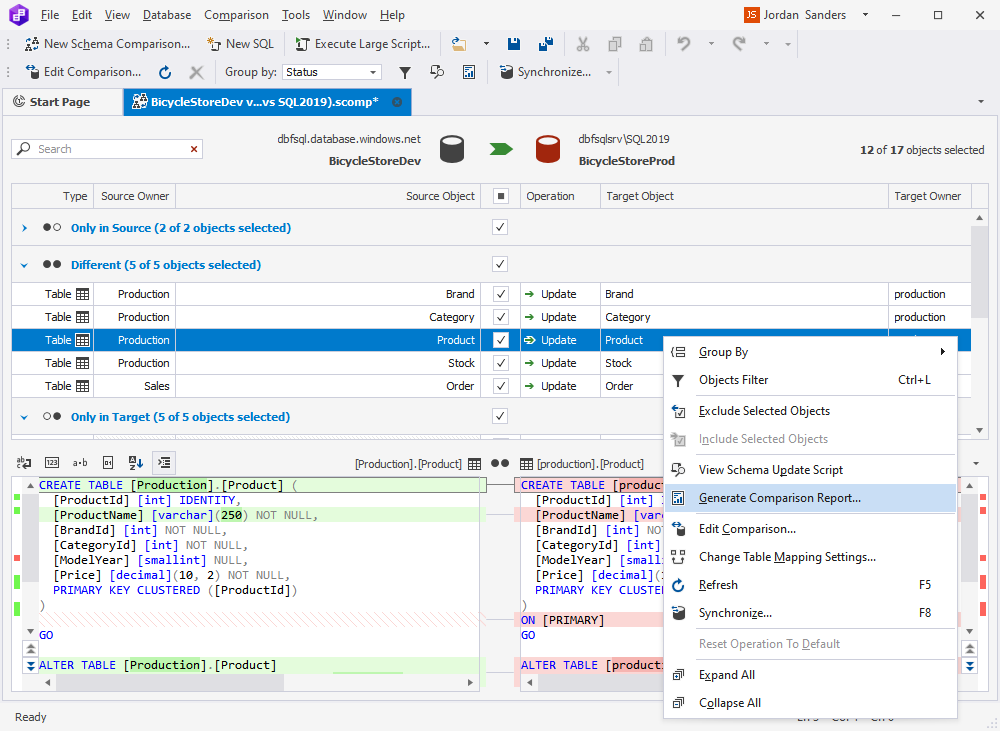
dbForge Data Compare for SQL Server
dbForge Data Compare for SQL Server is a tool for comparing and synchronizing data of Azure SQL databases. The top feature of the tool is the capability to compare custom query results. Also, dbForge Data Compare for SQL Server can save your time and effort by automating data comparison and synchronization tasks.
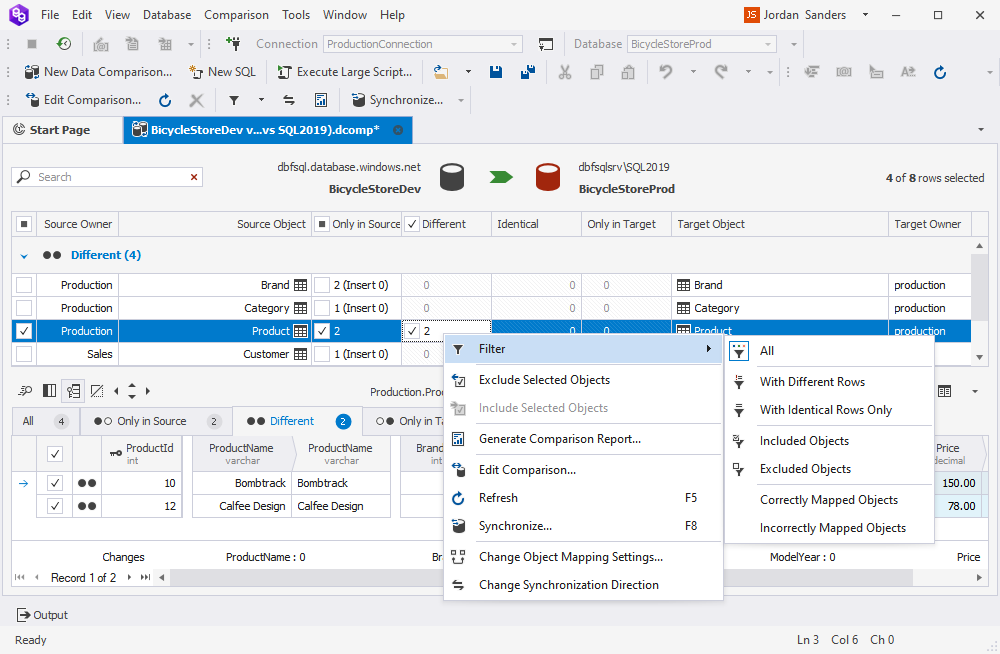
dbForge Query Builder for SQL Server
dbForge Query Builder for SQL Server is designed to simplify the development of different types of SQL queries. It is the right tool for those who want to create SQL queries of any complexity with the least effort. You can build database queries, add and edit tables, analyze and process a lot of data via a neat and intuitive UI.
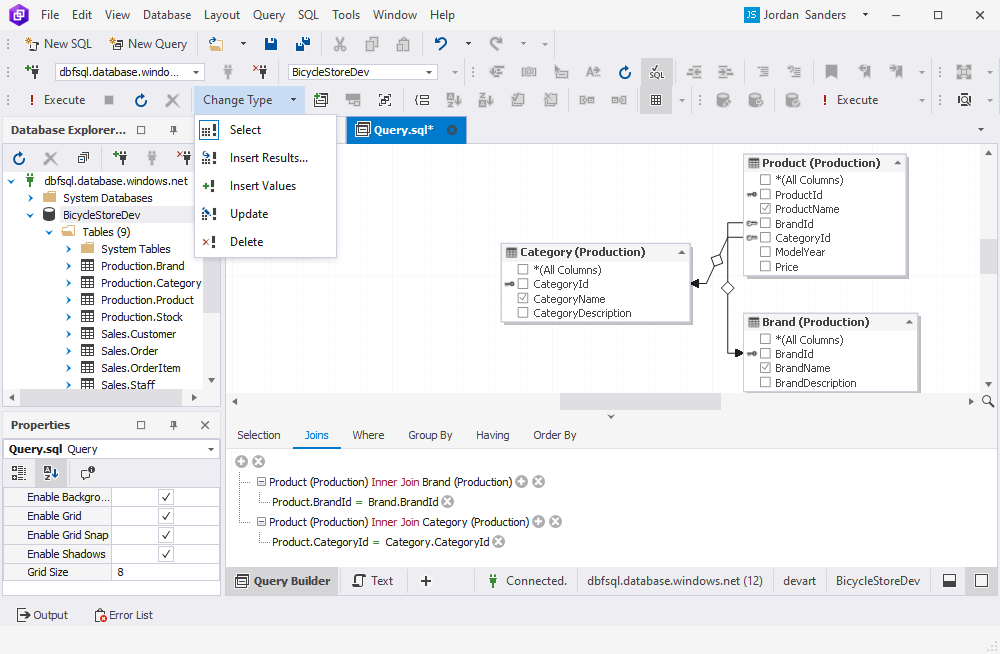
dbForge Data Generator for SQL Server
dbForge Data Generator for SQL Server is an indispensable tool when you need to populate databases with any amount of test table data. The tool includes 200+ predefined data generators with sensible configuration options that allow you to emulate column-intelligent random data. Also, Data Generator produces demo data for databases already filled with data and creates your own custom test data generators.
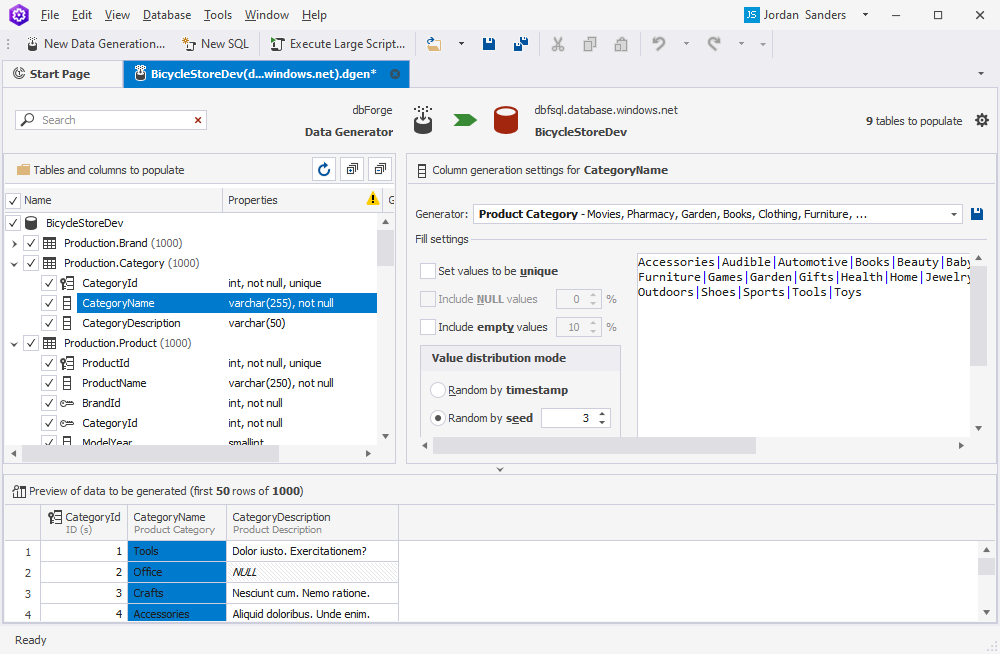
Conclusion
Nowadays, the development sphere has opened up new opportunities and prospects for us. We can choose what tools to work with, what platforms to use for applications’ deployments, and what cloud provider to entrust our infrastructure to.
Devart monitors modern software market trends and delivers profitable database development and management solutions. The company provides a range of reliable and efficient products designed to meet specific needs for developing, managing, and deploying databases. You can try dbForge SQL Complete for free by installing its 14-day trial version, or use a 30-day trial version of dbForge Studio for SQL Server for immersive GUI experience. Download our products and evaluate their effectiveness when working with Azure.
FAQ
1. What are the tiers of Azure SQL Database?
Azure SQL Database offers two purchasing models: the DTU-based model and the vCore-based model. The DTU model includes Basic, Standard, and Premium tiers, while the vCore model includes General Purpose, Business Critical, and Hyperscale tiers.
2. What are the Azure SQL service levels?
The main service levels for Azure SQL Database are General Purpose, Business Critical, and Hyperscale. Each is designed to meet different performance and availability requirements.
3. What are the tiers of DTU in Azure SQL Database?
The DTU model in Azure SQL Database includes the Basic tier for lightweight workloads, the Standard tier for balanced performance and cost, and the Premium tier for high-performance and low-latency needs.
4. What are the Azure MySQL tiers?
Azure Database for MySQL provides Basic for development and testing, General Purpose for most production workloads, and Memory Optimized for performance-intensive applications.
5. What is the Azure SQL Database?
Azure SQL Database is a cloud-based relational database service provided by Microsoft. It is a fully managed Platform-as-a-Service (PaaS) that handles maintenance, updates, backups, and scaling automatically.
6. What is the difference between an Azure SQL Database and a SQL Database?
Azure SQL Database is a cloud-native, fully managed service. In contrast, an SQL database like SQL Server is typically hosted on-premises or in a virtual machine and is managed entirely by the user.
7. Is Azure SQL Database free?
Azure SQL Database is not entirely free, but Microsoft provides a 12-month free tier with limited usage and offers a free trial credit. Continued use beyond the free tier is billed based on the selected service tier and resource consumption.
8. What are the different types of databases in SQL Azure?
SQL Azure includes Single Database, Elastic Pool, Managed Instance, and SQL Server hosted on Azure Virtual Machines. Each type supports different levels of control, scalability, and management.
9. What are the 4 types of databases in SQL?
The four types of databases in SQL are hierarchical databases, network databases, relational databases, and object-oriented databases.

